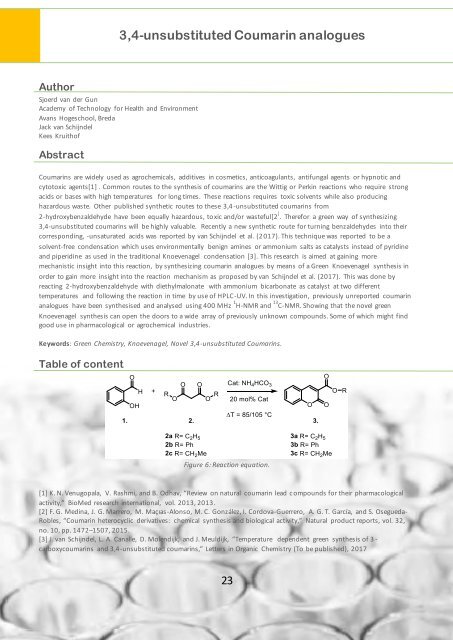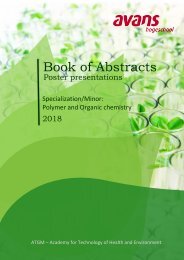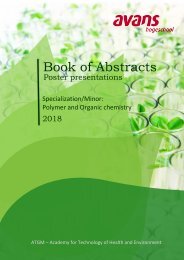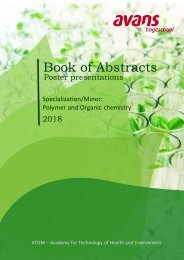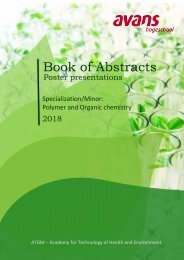Book of abstracts version 5
You also want an ePaper? Increase the reach of your titles
YUMPU automatically turns print PDFs into web optimized ePapers that Google loves.
<strong>Book</strong> <strong>of</strong> <strong>abstracts</strong> SPOC 2018<br />
3,4-unsubstituted Coumarin analogues<br />
Author<br />
Knoevenagel synthesis <strong>of</strong> novel<br />
marin analogues<br />
Sjoerd van der Gun<br />
Academy <strong>of</strong> Technology for Health and Environment<br />
Avans Hogeschool, Breda<br />
Jack van Schijndel<br />
Kees Kruith<strong>of</strong><br />
Abstract<br />
Coumarins are widely used as agrochemicals, additives in cosmetics, anticoagulants, antifungal agents or hypnotic and<br />
cytotoxic agents[1] . Common routes to the synthesis <strong>of</strong> coumarins are the Wittig or Perkin reactions who require strong<br />
acids or bases with high temperatures for long times. These reactions requires toxic solvents while also producing<br />
hazardous waste. Other published synthetic routes to these 3,4 -unsubstituted coumarins from<br />
2-hydroxybenzaldehyde have been equally hazardous, toxic and/or wasteful[2 ] . Therefor a green way <strong>of</strong> synthesizing<br />
3,4-unsubstituted coumarins will be highly valuable. Recently a new synthetic route for turning benzaldehydes into their<br />
corresponding, -unsaturated acids was reported by van Schijndel et al. (2 017). This technique was reported to be a<br />
solvent-free condensation which uses environmentally benign amines or ammonium salts as catalysts instead <strong>of</strong> pyridine<br />
and piperidine as used in the traditional Knoevenagel condensation [3]. This research is aimed at gaining more<br />
mechanistic insight into this reaction, by synthesizing coumarin analogues by means <strong>of</strong> a Green Knoevenagel synthesis in<br />
order to gain more insight into the reaction mechanism as proposed by van Schijndel et al. (2017). This was done by<br />
reacting 2-hydroxybenzaldehyde with diethylmalonate with ammonium bicarbonate as catalyst at two different<br />
temperatures and following the reaction in time by use <strong>of</strong> HPLC-UV. In this investigation, previously unreported coumarin<br />
analogues have been synthesised and analysed using 400 MHz 1 H-NMR and 13 C-NMR. Showing that the novel green<br />
Knoevenagel synthesis can open the doors to a wide array <strong>of</strong> previously unknown compounds. Some <strong>of</strong> which might find<br />
good use in pharmacological or agrochemical industries.<br />
Keywords: Green Chemistry, Knoevenagel, Novel 3,4-unsubstituted Coumarins.<br />
Table <strong>of</strong> content<br />
Figure 6: Reaction equation.<br />
[1] K. N. Venugopala, V. Rashmi, and B. Odhav, “Review on natural coumarin lead c ompounds for their pharmacological<br />
activity,” BioMed research international, vol. 2013, 2013.<br />
[2] F. G. Medina, J. G. Marrero, M. Maçıas-Alonso, M. C. González, I. Cordova-Guerrero, A. G. T. García, and S. Osegueda-<br />
Robles, “Coumarin heterocyclic derivatives: chemical synthesis and biological activity,” Natural product reports, vol. 32,<br />
no. 10, pp. 1472–1507, 2015.<br />
[3] J. van Schijndel, L. A. Canalle, D. Molendijk, and J. Meuldijk, “Temperature dependent green synthesis <strong>of</strong> 3 -<br />
carboxycoumarins and 3,4-unsubstituted coumarins,” Letters in Organic Chemistry (To be published), 2017<br />
23


